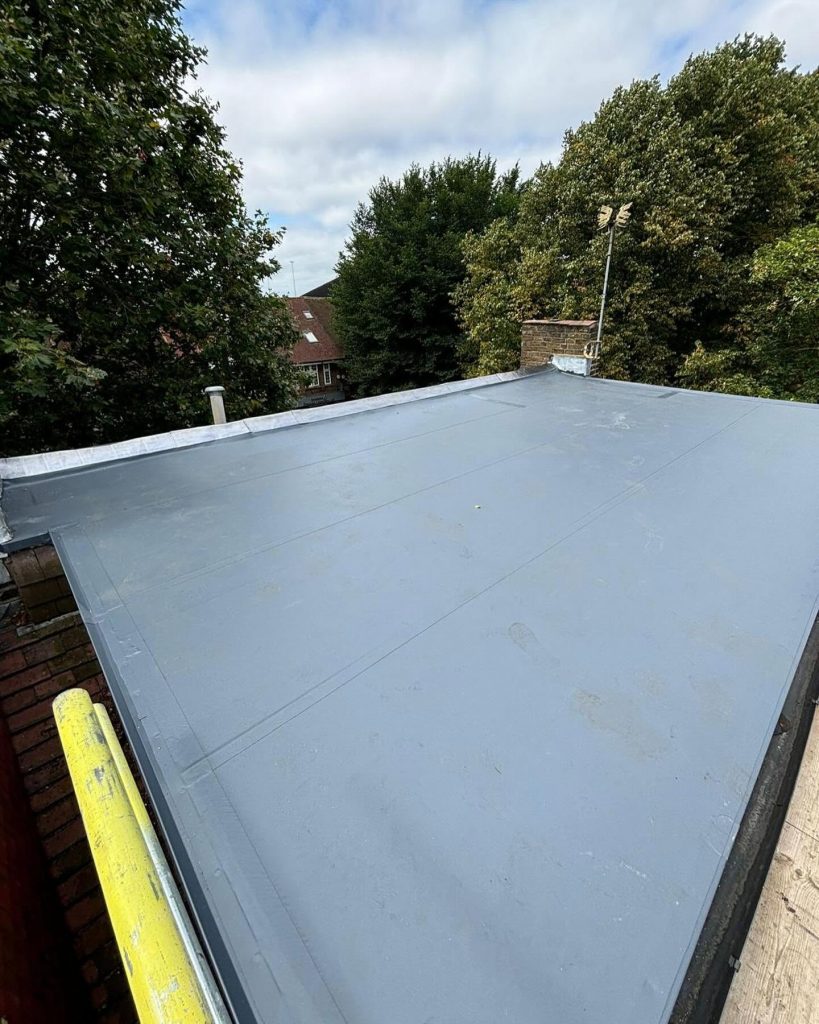If you’re planning a new build or thinking about a roof replacement, one of the first choices you’ll face is this: flat roof or pitched roof? It’s not just about appearance — the decision has implications for budget, long-term maintenance, and how your home performs in different weather conditions.
We get asked about this all the time here at Surrey Roofer, especially by homeowners looking to upgrade older roofs or extend their properties. Both flat and pitched roofs have their strengths, and choosing the right one depends on your needs, the property type, and the look you’re going for.
Let’s break it down.
What Is a Flat Roof?
Despite the name, flat roofs aren’t completely flat. They have a slight pitch (usually around 1 to 10 degrees) to allow water to drain away. You’ll often see them on extensions, garages, garden offices, and some modern-style homes.
In recent years, flat roofs have come a long way. Older flat roofs — particularly those built in the ’60s and ’70s — had a bit of a reputation for leaking or pooling water. But new materials like GRP fibreglass, EPDM rubber, and torch-on felt mean today’s flat roofs are much more durable and low maintenance.
They’re sleek. Clean. Minimal. And often more affordable upfront than a pitched roof.
What Is a Pitched Roof?
A pitched roof is the traditional, angled roof you’ll find on most houses in the UK. It’s usually made up of two sloping sides that meet at a peak. Depending on the design, it can be shallow or steep.
Pitched roofs can be tiled (with clay, slate, or concrete), and they allow for better water runoff, which is particularly handy in rainy places like Surrey.
They also tend to have a longer lifespan than flat roofs — often 50 years or more — and they offer space underneath for loft storage or even conversion.
Key Differences to Consider
1. Cost
Flat roofs are generally cheaper to install. There’s less material involved, the structure is simpler, and labour time is shorter. This makes them an attractive option for extensions or budget-conscious homeowners.
But it’s worth noting that while they’re cheaper upfront, they can have slightly higher long-term maintenance costs, especially if drainage isn’t perfect or the roof is poorly installed.
Pitched roofs cost more to build because they require more materials and time. But their longer lifespan and lower risk of issues like water ingress can make them better value over decades.
2. Lifespan
Modern pitched roofs can last anywhere between 40–100 years, depending on the materials used. Tile roofs tend to outlast felt or rubber flat roofs.
Flat roofs, on the other hand, usually last around 20–30 years with proper maintenance. Newer systems like fibreglass and EPDM can push this further, but they still don’t quite match the durability of a good tiled roof.
3. Appearance
Flat roofs are often chosen for modern or minimalist builds. They can help create a streamlined, contemporary look and work well with large windows or boxy designs.
Pitched roofs offer a more traditional look and suit older homes, period properties, or anything aiming for a classic British aesthetic.
If you’re adding an extension to a Victorian semi, a flat roof might be the better way to differentiate it from the original building while keeping planning officers happy.
4. Planning Permission and Building Regulations
In most cases, replacing an existing roof or adding an extension with either a flat or pitched roof doesn’t need planning permission — unless you’re altering the height or shape significantly.
However, flat roofs are sometimes easier to get through planning on rear extensions or outbuildings, particularly in built-up areas or near shared boundaries.
Whatever your plans, we always recommend checking with your local council or speaking to your roofer — we’re always happy to advise on Surrey’s specific regulations.
5. Insulation and Energy Efficiency
Pitched roofs have the upper hand here. They tend to be better ventilated and allow for more insulation space, making your home more energy efficient in the long run.
That said, modern flat roofs can be built as “warm roofs,” where insulation is placed above the structural deck rather than underneath. This improves heat retention and helps prevent condensation issues.
If energy efficiency is a priority, make sure your roofer is up to speed on current Building Regs and uses the right type of insulation for the structure.
6. Maintenance
Flat roofs need checking a little more often. Leaves, moss, and debris can build up and block outlets. If pooling water is left to sit, it can damage the membrane or cause small leaks over time.
Pitched roofs, because of their slope, naturally shed water and debris more easily. But they aren’t maintenance-free — cracked tiles, ridge damage, and slipped slates still need dealing with before they cause trouble.
With both types, annual inspections go a long way in preventing bigger problems.
7. Space and Usability
Pitched roofs create loft space. Whether you use that for storage or turn it into an extra bedroom is up to you, but the potential is there.
Flat roofs don’t offer that, but they do allow for more creative uses — like green roofs, roof lanterns, or even roof terraces if you’re building something high-end.
They also work well on low-height extensions, where adding a pitched roof would make the building too tall or look out of proportion.
Ultimately, the choice comes down to what you need, how the roof fits in with the rest of the house, and what your budget looks like. At Surrey Roofer, we work with both flat and pitched roofs across the region — from traditional re-roofs to sleek new extensions.
If you’re unsure which type of roof is best for your project, get in touch for honest advice and a no-obligation quote. We’ll help you figure out what makes the most sense for your home, not just now, but in the years to come.
